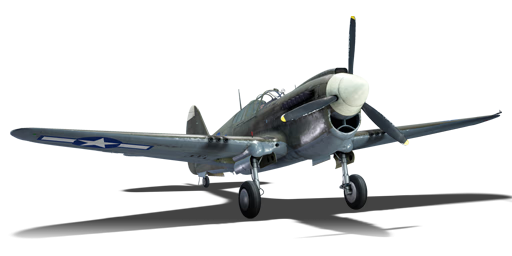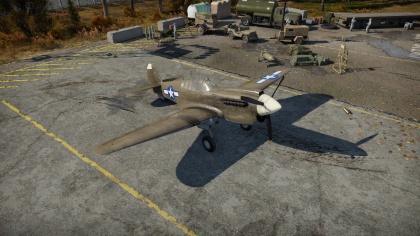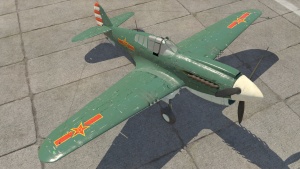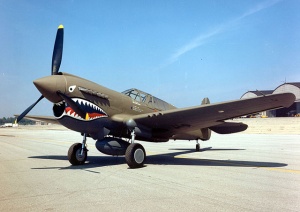P-40E-1
Contents
| This page is about the American fighter P-40E-1. For other uses, see P40 (Disambiguation). For other vehicles of the family, see P-40 (Family). |
Description
The P-40E-1 Warhawk is a Rank II American fighter
with a battle rating of 2.3 (AB/SB) and 2.7 (RB). This aircraft has been in the game since the start of the Open Beta Test prior to Update 1.29.
The P-40E Warhawk is an excellent "boom-n-zoom" fighter/bomber, however, it is not limited to this kind of warfare. It is equipped with 6 x M2 Browning .50 cal machine guns which are remarkably effective against light pillboxes, some light tanks/AAA, and of course, planes. The P-40 can also equip bombs to round itself out as a decent low-rank fighter bomber.
Any competent realistic battle Warhawk flyer will tell you that it is only good at Medium altitudes (3,000 m is normally considered that middle altitude). This is because the engine's performance is poor at higher altitudes, unlike its future successors- the P-51 and P-47. The P-40's main asset is its straight-line speed- it will easily outrun Bf 109s, A6Ms, and some "modernized" biplanes you may see at its 2.3 battle rating. Head-ons are almost never advisable, but given the high velocity and fire rate of the .50 cals, lightly armoured planes such as the A6M can be taken head-on from a distance.
Otherwise, use the high speed and decent engine performance at low altitude to out-speed and energy-fight enemy planes. At high speeds, the P-40 can out-turn a select few Axis and British fighters, including some lower-rank Bf 109s and Hawker Hurricanes. Never attempt to turn with Zero's, He 112s, Spitfires or low-rank Russian fighters as they will almost always have the turn advantage and get the better angle of attack.
In short, the P-40 is one of the best performing low-rank US planes due to its high speed and general performance which outmatches most, if not all, opponents at the 2.3 battle rating.
General info
Flight Performance
Describe how the aircraft behaves in the air. Speed, manoeuvrability, acceleration and allowable loads - these are the most important characteristics of the vehicle.
| Characteristics | |||||||
|---|---|---|---|---|---|---|---|
| Stock | |||||||
| Max Speed (km/h at 3,810 m) |
Max altitude (meters) |
Turn time (seconds) |
Rate of climb (meters/second) |
Take-off run (meters) | |||
| AB | RB | AB | RB | AB | RB | ||
| 528 | 513 | 9,555 | 22.3 | 22.7 | 4.6 | 6.7 | 343 |
| Upgraded | |||||||
| Max Speed (km/h at 3,810 m) |
Max altitude (meters) | Turn time (seconds) | Rate of climb (meters/second) |
Take-off run (meters) | |||
| AB | RB | AB | RB | AB | RB | ||
| 603 | 575 | 9,555 | 20.2 | 20.6 | 22.0 | 12.4 | 343 |
Details
| Features | ||||
|---|---|---|---|---|
| Combat flap | Take-off flap | Landing flap | Air brakes | Arrestor gear |
| ✓ | ✓ | ✓ | X | X |
| Limits | ||||
|---|---|---|---|---|
| Wing-break speed (km/h) |
Gear limit (km/h) |
Combat flap (km/h) |
Max Static G | |
| + | - | |||
| 772 | 290 | ??? | ~16 | ~7 |
| Optimal velocities | |||
|---|---|---|---|
| Ailerons (km/h) |
Rudder (km/h) |
Elevators (km/h) |
Radiator (km/h) |
| < 458 | < 380 | < 450 | > 200 |
| Compressor (RB/SB) | ||
|---|---|---|
| Setting 1 | ||
| Optimal altitude | 100% Engine power | WEP Engine power |
| 3,108 m | 1,070 hp | 1,198 hp |
Survivability and armour
- 38 mm Bulletproof glass - Front windscreen
- 8 mm Steel - Behind pilot's seat
- 6.35 mm Steel - Between cockpit and engine
Armaments
Offensive armament
The P-40E-1 is armed with:
- 6 x 12.7 mm Browning M2 machine guns, wing-mounted (225 rpg outer, 260 rpg middle, 295 rpg inner = 1,560 total)
The P-40E-1 with its six .50 calibre machine guns are much like a precursor to the P-47 with its eight .50 calibre machine guns. While not as devastating as a 20 mm autocannon, the six machine guns when connecting with a target will do a considerable amount of damage, to the point of causing a critical hit if not blowing off a wing or severing a fuselage. Unlike aircraft with nose-mounted weapons, the wing-mounted guns require the pilot to set a convergence point. Typically a convergence point is set around 250 - 400m (or even closer if you typically fly on the enemy's tail) will be enough to thoroughly dismantle an enemy airplane. Though the guns can be pushed to fire at aircraft which are further away, however, they start losing their punch and chances of critically damaging the enemy starts dropping. Due to the issue of convergence, head-on attacks are discouraged unless the pilot is proficient at cantering the aircraft slightly so that one set of guns fires in a straight path towards the head-on attacker.
Suspended armament
The P-40E-1 can be outfitted with the following ordinance:
- Without load
- 2 x 100 lb AN-M30A1 bombs (200 lb total)
- 1 x 500 lb AN-M64A1 bomb (500 lb total)
- 2 x 100 lb AN-M30A1 bombs + 500 lbs AN-M64A1 bomb (700 lb total)
As an early version of a multi-role aircraft, the P-40E-1 can be configured as a fighter/interceptor or a fighter/bomber. Bombs can be outfitted to the P-40E-1 to allow for strategic bombing and low altitudes, many times during a diving run. Less effective at bombing bases, this fighter can lob the bombs to pick off smaller and lighter targets which may be spread across the map and once the bombs are released, it can resume its fighter role. The disadvantage of carrying bombs on this aircraft come with reduced manoeuvrability. The roll rate of this aircraft dramatically changes when carrying the two 100 lb bombs under the wings, however, the single 500 lb bomb though heavier, with its being mounted on the fuselage hardpoint it doesn't affect the roll rate as much.
Usage in battles
Air Combat
The P-40 is good at turn fights and low altitude fights only against fighters like Bf 109's which it faces, e.g. the E-3, G-2s and F-4s; these aircraft cannot really turn with it but are faster. The speed of this aircraft at 560 kph makes it pretty fast for its rank and BR, however, this is only applicable to low altitudes. An important point is that the aircraft engine chokes above 5,000 m and becomes basically a sitting duck at this altitude.
When you dive on other planes, watch your speed! The P-40 is nearly uncontrollable at speeds higher than 600 kph - its ideal speed is between 400 - 500 kph. However, structurally, the P-40 is surprisingly strong and can turn/dive very quickly at high speeds.
Compared to other planes at the 2.3 battle rating, the P-40 is fairly well-armed. The 6 x M2 machine guns can rip apart most enemy aircraft. A well-trained burst can take any fighter, however, some attackers (namely the well-armoured IL-2) and larger bombers might take a little bit more patience and a few more passes. Ammo capacity is also very good and will easily last an entire RB match, given that the pilot has good accuracy and trigger control.
In short, always remember to energy fight and use the P-40's high top speed to quickly dive away and leave combat if things get hairy.
The Ground Attack Role
The P-40E can carry a bomb payload of 2 x 100 lb or 1 x 500 lb or 2 x 100 lb + 1 x 500 lb (700 lb), making it a decent ground attack fighter for its rank. The Ground Targets belt for the .50 cals allow the P-40 to rip apart enemy AAA, Pillboxes, and even most German/Japanese light tanks. Pz. IIs, bt-5 and -7s, Chi-Ha's, etc., can all be torn to shreds with the .50 cals- primarily from the side and top.
Some concerning fighters that the P-40E-1 should worry about are:
- Bf 109s: Emil
- A6M2, the "Zero"
- Yak 1B/Yak-7B
- Spitfires: Mk.II, Mk.Vb )
- Hurricane Mk IVs with mounted cannons
Against the Bf 109:
Turn flight- the BF-109 is typically a superior aircraft in terms of climb rate and vertical manoeuvres. However, early/mid-rank 109s can be turned against in the Warhawk, especially at higher speeds.
Against the Zero:
- Boom & Zoom - dive on the target and engage. Due to its lack of armour and large fuel tanks, the A6M is easy to destroy.
- Outrun the A6M- the A6M isn't a really high-speed plane, the P-40E can outrun it flat-out easily, so turn around after 3-4km and try to head-on or start climbing then. The A6M might start to climb to try and gain energy- if you keep running from it, you will put enough space between you and your opponent to climb to an acceptable altitude, or re-group with allies
Never, ever, ever turn fight a Zero. Zeros are the natural and historical nemeses of Allied aircraft, and those 2 x 20 mm cannons can rip P-40s to shreds.
Against the Yak-1/7:
- Turn fighting is recommended as a last resort, especially with the Yak-1B's superior handling and turn-radius. You will not be able to outrun a Yak and head-ons are not advised due to the Yak's nose weapons. Try and get a friend to assist you, without losing speed- avoid engaging and losing speed, otherwise, the Yak will catch you. If you are in a squad, stick together and use the scissor-baiting method, until an opponent locks onto one of you, then you can destroy it. Boom and zoom should be used, but the circumstances often don't arise.
Against Spitfires:
- Try to Boom & Zoom, if given the position to do so. In a straight line, the P-40 will outrun a Spitfire Mk.I at lower altitudes, but not out-climb it. The performance of the Spitfire makes it a difficult enemy, only turn fight with it at high speeds, with wingmen or more teammates around is the optimal solution. The P-40E-1 is also more heavily armed than a Spitfire, so attempting to risk a head-on shot may pay off, especially since both aircraft have to deal with convergence issues. However, skilled Spitfire pilots will not be baited into such a shot and will usually break off before an effective firing solution can be achieved.
Against the Hurricane Mk. IV (mounted with cannons)
- Do not go head-on! This specific vehicle has the most potent cannon installed on a fighter at or around this battle rating (the second being your P-39). Any tactic that is not a frontal attack is effective. Something else to note that is the Hurricane Mk. IV's controls will lock up at slower speeds than the P-40E-1's in the vertical, thus giving the P-40 an advantage when making high-speed manoeuvres while diving. However, the Hurricane is much more manoeuvrable even with the gun pods installed and can reverse the roles if the attacker is not careful.
Manual Engine Control
| MEC elements | ||||||
|---|---|---|---|---|---|---|
| Mixer | Pitch | Radiator | Supercharger | Turbocharger | ||
| Oil | Water | Type | ||||
| Controllable | Not controllable | Not controllable | Not controllable | Separate | Not controllable | Not controllable |
Modules
| Tier | Flight performance | Survivability | Weaponry | ||
|---|---|---|---|---|---|
| I | Fuselage Repair | Radiator | Offensive 12 mm | ||
| II | Compressor | Airframe | FSBC mk.1 | ||
| III | Wings repair | Engine | New 12 mm MGs | ||
| IV | Engine Injection | Cover | FMBC mk.1 | ||
- The primary modules to focus on are ammo belts and performance. For best results in air to air combat the Universal belts are recommended.
Pros and cons
Pros:
- Powerful low to mid-altitude performance
- Decent roll rate
- Lots of vibrant and historically accurate camouflage to unlock
- Good flat out speed
- Good dive speed
- Fast at level flight
- Can carry bombs
- Somewhat adequate cockpit visibility despite lots of bars
- Pilot is protected by a steel plate behind his seat and by another plate and a bulletproof glass from the front
- Deadly armament (6 x 50.cal HMGs), easily rip apart any opponents
- Extremely strong rudder, can help with manoeuvres a lot and decrease turn radius (AB)
Cons:
- Poor climb rate
- Poor high altitude performance
- Poor turn time compared to other single-seat fighters of similar time period and rank
- Poor energy retention
- Low ammunition count
- Elevators completely lock up at 600 KM/H(352 MP/H)
- Rear visibility from the cockpit is hindered by the armour plate
- Unstable in yaw axis (RB and SB)
- Must adjust for convergence of wing-mounted guns
History
Development
The P-40 was born in 1938 when Curtiss realized the need for a replacement to the P-36. The P-36 was a formidable aircraft, but top speeds of newer fighter designs were quickly passing it. Donovan Berlin a former Northrop engineer who was employed by Curtiss went to work on the redesign of the Hawk. The radial engine was replaced with a turbo-supercharged version of the Allison V-1710 inline engine. The cockpit was moved to offset the weight of the new engine. This delivered a performance boost and higher top speeds when tested. The Army ordered thirteen versions of this prototype built for additional testing. Unfortunately, the experimental turbo-supercharged engine was unreliable and poor visibility from the cockpit forced the project to be abandoned.
The next attempt at design was a simpler one. Berlin recognized the U.S. Army believed they only needed a fighter effective to only 15,000 ft. The aircraft's engine was replaced with a simpler supercharged Allison engine and was designated XP-40. The new prototype first flew on October 14, 1938. The aircraft flew and looked good but various adjustments were quickly made. These included moving the radiator and a more powerful version of the Allison V-1710. The XP-40 was quickly recognized for its good handling and dive speeds.
Procurement
On April 26, 1939, Curtiss was handed a record-setting contract of 524 P-40s for $13 million. The primary reason Curtiss won the contract was due to availability. Other manufacturers still needed a couple of years before they could launch their aircraft into production (Examples: P-38, P-39). The first production P-40 rolled off the factory line in March of 1940. The first P-40s to see action were RAF Tomahawks over North Africa in June of 1941. The aircraft was quickly noted for being a stable gun platform and capable of withstanding more battle damage than its counterparts. The aircraft's altitude limitations quickly forced pilots to accept they would have to endure higher flying opponents.
When the P-40 reached the D and E variants many changes had to be made. Allison redesigned its V-1710 and the aircraft's fuselage when need to accommodate the higher thrust and additional horsepower from the new engine. Curtiss removed all armament from the nose of the aircraft and placed four 12.7 mm Browning M2 machine guns in the wing. In the later E model that number would be increased to six. The P-40 was also fitted with an improved cockpit enclosure, larger windshield, and a better canopy. The P-40E-1 was also capable of carrying six small bombs under the wings. In late production models, a small dorsal fin was added near the base of the tail for added stability.
Design
The Curtiss P-40E Kittyhawk was an American single-engine, single-seat, fighter/ground-attack aircraft that first flew in 1938. Better known as the "Warhawk," the P-40 series design was a modification of the previous Curtiss P-36 Hawk. The Kittyhawk was used by most Allied powers in World War II and remained in the front lines until the end of the war. It was the third most-produced American fighter, the first two being the P-51, and the P-47. Production of the Kittyhawk ceased in November of 1944. By that time, 13,738 has been built.
Although many models of the P-40 were built, the model series was officially given the general name "P-40 Warhawk," making all planes off the P-40 series P-40 Warhawk's, although British and Soviet air forces gave the Warhawk the name "Tomahawk" for any models equivalent to the P-40B and P-40C. The name "Kittyhawk" was given to any models equivalent to the P-40D and above.
Combat usage
The P-40 series first saw combat not in North America, but in the Middle East and North African campaigns, being flown by British pilots, during the June of 1941. No. 112 Squadron Royal Air Force was one of the first squadrons to operate the Warhawks, (Considered "Tomahawks" by the pilots that flew them,) and was the first unit of Allied forces to use the "Shark Mouth" decal, copying similar German markings that were used on some Messerschmitt Bf 110's.
The P-40 was inferior to some German single-engine fighters in high-altitude combat due to its lack of a two-stage supercharger. This caused the P-40 to be rarely used in operation in Northwest Europe. But between the years of 1941 and 1944, the P-40 played a critical role in the theatres North Africa, the Southwest Pacific, and China. It also had a considerable role in the Middle East, Southeast Asia, Eastern Europe, Alaska, and Italy. The P-40's bad high-altitude performance did not matter in these theatres, where it was used as an air superiority fighter, bomber escort, and a fighter-bomber. Although the design was considered mediocre in postwar, suitable for only close air support, Allied pilots reported the P-40 flew surprisingly well as an air superiority fighter. The P-40 also had the advantage of low-cost assembly, which kept it in production as a ground-attack aircraft long after it was considered obsolete as a fighter. A survey conducted in 2008 showed that at the time, 29 P-40's were airworthy.
In-game description
Allied forces have used this American single-engine fighter all over the world: in Europe, Africa, Asia and the Pacific theater. P-40E-1 'Kittyhawk' modification of that plane, made for the British Air Force, was equipped with an Allison V-1710-39 engine and armed with six 12.7 mm. Browning machine guns. The plane could optionally carry 500 pounds of bombs under its fuselage and 100 pounds of bombs on each wing. There were more than 1,500 P-40E-1s produced.
Media
- Images
- Videos
See also
- Related development
- Curtiss P-36 Hawk
- Curtiss P-40 (Family)
- Aircraft of comparable role, configuration and era
- Bell P-39 Airacobra
- Dewoitine D.520
- Grumman F4F Wildcat
- Hawker Hurricane
- Kawasaki Ki-61
- Lavochkin-Gorbunov-Gudkov LaGG-3
- Macchi C.202
- Messerschmitt Bf 109
- Mikoyan-Gurevich MiG-3
- Mitsubishi A6M Zero
- Supermarine Spitfire
- Yakovlev Yak-1
External links
| Curtiss-Wright Corporation | |
|---|---|
| Fighters | BF2C-1 |
| P-36A · Rasmussen's P-36A · P-36C · P-36G | |
| P-40C · P-40E-1 · P-40F-10 | |
| Bombers | SB2C-1C · SB2C-4 |
| Floatplanes | SOC-1 |
| Experimental | XP-55 |
| Export | H-75A-1 · H-75A-4 · H-81A-2 · ▂P-40E-1 · ␗P-40E-1 · ▄P-40F-5 Lafayette · CW-21 · Hawk III |
| ▄SB2C-5 | |
| Captured | ▀Hawk H-75A-2 |
| USA fighters | |
|---|---|
| P-26 Peashooter | P-26A-33 · P-26A-34 · P-26A-34 M2 · P-26B-35 |
| P-36 Hawk | P-36A · Rasmussen's P-36A · P-36C · ○P-36C · P-36G |
| P-39 Airacobra | P-400 · P-39N-0 · P-39Q-5 |
| P-40 | P-40C · P-40E-1 · P-40E-1 TD · P-40F-10 |
| P-43 Lancer | P-43A-1 |
| P-47 Thunderbolt | P-47D-22-RE · P-47D-25 · P-47D-28 · P-47M-1-RE · ⋠P-47M-1-RE · P-47N-15 |
| P-51 Mustang | P-51 · P-51A (Thunder League) · P-51C-10 · P-51D-5 · P-51D-10 · P-51D-20-NA · P-51D-30 · P-51H-5-NA |
| P-63 Kingcobra | P-63A-5 · P-63A-10 · P-63C-5 · ␠Kingcobra |
| Prototypes | XP-55 |
| F2A Buffalo | F2A-1 · Thach's F2A-1 · F2A-3 |
| BF2C | BF2C-1 |
| F3F | F3F-2 · Galer's F3F-2 |
| F4F Wildcat | F4F-3 · F4F-4 |
| F4U Corsair | F4U-1A · F4U-1A (USMC) · F4U-1D · F4U-1C · F4U-4 · F4U-4B · F4U-4B VMF-214 · F2G-1 |
| F6F Hellcat | F6F-5 · F6F-5N |
| F8F Bearcat | F8F-1 · F8F-1B |
| Other countries | ▃Ki-43-II · ▃Ki-61-Ib · ▃A6M2 · ▃Bf 109 F-4 · ▃Fw 190 A-8 · ▃Spitfire LF Mk IXc |







